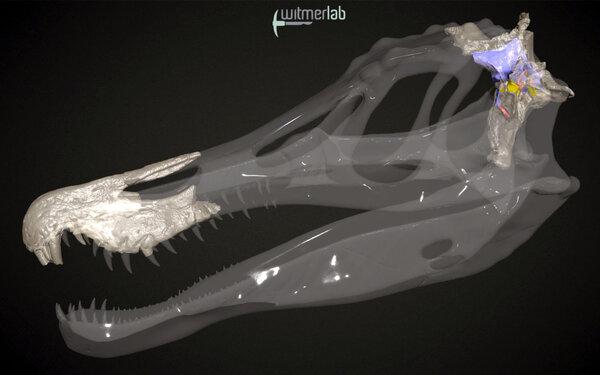Ohio University researchers help reveal evolution of oldest spinosaur brains
Researchers from Ohio University and the University of Southampton have reconstructed the brains and inner ears of two British spinosaurs, helping uncover how these large predatory dinosaurs interacted with their environment.
Lawrence M. Witmer, professor of anatomy at OHIO’s Heritage College of Osteopathic Medicine, and Ryan Ridgley, a research associate of 23 years in WitmerLab, specifically focused their research efforts and contributed information on Baryonyx, one of the species of spinosaurs highlighted in the study.

The most famous spinosaur is Spinosaurus itself, a 45-foot-long, sail-backed giant that was one of the stars of Jurassic Park III. Spinosaurs are an unusual group of theropod dinosaurs, equipped with long, crocodile-like jaws and conical teeth. These adaptations helped them live a somewhat-aquatic lifestyle that involved stalking riverbanks in quest of prey, among which were large fish. This way of life was very different from that of more familiar theropods, like Allosaurus and Tyrannosaurus.
To better understand the evolution of spinosaur brains and senses, the team scanned fossils of Baryonyx from Surrey and Ceratosuchops from the Isle of Wight. These two are the oldest spinosaurs for which braincase material is known. The huge creatures lived long before Spinosaurus and would have been roaming the planet about 125 million years ago. The braincases of both specimens are well preserved, and the team digitally reconstructed the internal soft tissues that had long rotted away.
The researchers found the olfactory bulbs, which process smells, weren’t particularly developed, and the ear was probably attuned to low frequency sounds. Those parts of the brain involved in keeping the head stable and the gaze fixed on prey were possibly less developed than they were in later, more specialized spinosaurs.

Findings were recently published in a freely accessible article in the Journal of Anatomy.
“Despite their unusual ecology, it seems the brains and senses of these early spinosaurs retained many aspects in common with other large-bodied theropods – there is no evidence that their semi-aquatic lifestyles are reflected in the way their brains are organized,” said University of Southampton Ph.D. student Chris Barker, who led the study.
One interpretation of this evidence is that the theropod ancestors of spinosaurs already possessed brains and sensory adaptations suited for part-time fish catching, and that ‘all’ spinosaurs needed to do to become specialized for a semi-aquatic existence was evolve an unusual snout and teeth.
“Because the skulls of all spinosaurs are so specialized for fish-catching, it’s surprising to see such ‘nonspecialized’ brains,” said contributing author Dr. Darren Naish. “But the results are still significant. It’s exciting to get so much information on sensory abilities – on hearing, sense of smell, balance and so on – from British dinosaurs. Using cutting-edged technology, we basically obtained all the brain-related information we possibly could from these fossils."
Witmer and Ridgley have been working on brain evolution for over 20 years, with many years of funding for this work coming from the National Science Foundation (NSF). Witmer has also been CT scanning dinosaurs, including Baryonyx, to learn more about their evolution and discover insight on their relationships with the environment for more than 25 years. Currently, the two researchers have received a major new grant from the Swedish Research Council to study the evolution of the brain and cognition with collaborators in Sweden, Scotland, and the Czech Republic.

“This new research is just the latest in what amounts to a revolution in paleontology due to advances in CT-based imaging of fossils,” Witmer, a co-author on the study, said. "We’re now in a position to be able to assess the cognitive and sensory capabilities of extinct animals and explore how the brain evolved in behaviorally extreme dinosaurs like spinosaurs.”
